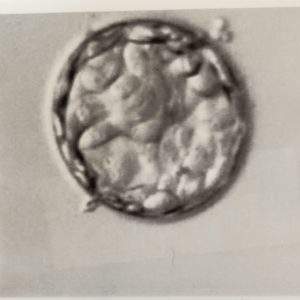The IVF Process Part III: Fresh Transfer and the Two Week Wait
By Alina Avery
Right after retrieval we were told that they had managed to collect 24 eggs. This seemed like a great number to me, and we expected to get a good haul as I was young and had responded to the medication well. Twenty-four seems like a huge number, and comparably it is, but during each stage of development, you can expect about 30% drop off. So from our 24 retrieved, not all would fertilize, and not all of those would develop, and not all of those would reach the 5-day blastocyst stage which is what’s required for transfer.
The next 24 hours were very anxious for me as I waited to hear how many eggs had managed to fertilize normally. I got the call fairly early the next day — we had 16 embryos! Off to a good start, and pretty spot on for the 30% drop off. At this point, I wouldn’t receive any more updates on how many embryos continued to develop until I showed up four days later for the transfer. They prefer to leave them alone in the incubator to grow rather than disturb them. If you didn’t have many to start with or they suspected the embryos might not reach day-5, they sometimes check them early and schedule a day-3 transfer. The philosophy being that the embryos will do better in their natural environment rather than in a lab. But since we still had a good amount growing, I wouldn’t hear anything for 4 more days. I thought those were the longest 4 days… turns out there would be a lot more waiting and anticipating in this process! I was also instructed to start a combination of estrogen and progesterone supplements in order to prepare my body for the transfer.
A few days later I received a call letting me know what time I should arrive for my fresh transfer and other instructions. Essentially, at this point the uterus is quite small and they use an external ultrasound to help guide the placement of the embryo. They can get a better image if you have a full bladder. You’re told to drink 16 oz or so of water on your way in to the clinic and not to empty your bladder until after the transfer. It’s… uncomfortable.
So Matt and I arrived for the transfer, bladder full (mine, not his!), waited a bit, and then went into a room adjacent to the lab where the embryologists work. I signed some forms, including instructions for what to do and not to do post transfer and when to come back for a pregnancy blood test. I got all situated on the table, and the doctor and nurse came in. The doctor explained that we had a great looking embryo that day to transfer, graded a 5AA, and several more that they would be able to freeze. I would get an email the next morning with the exact number, but it was at least 5 so I was feeling pretty relieved about that after 5 days in the dark. The embryologist brought in the embryo in a petri dish and matched it to my wristband to make sure they had the right one. Once they were sure they had the right embryo, they gave me a little picture of it to keep, and we got started. The procedure is very similar to a pap smear. There’s a speculum involved, which is also uncomfortable of course, and then the doctor inserts a larger guiding catheter while the nurse (or maybe a technician?) guides the placement with an ultrasound. Once the outer catheter is in place, the embryologist brings back in the embryo, this time along with some fluid in a smaller catheter. The small tube gets inserted into the larger one and gets “flushed” into the uterus. Matt held my hand the whole time and we watched as much as we could on the ultrasound screen. You can’t really see anything much except the outline of the uterus and a little flash of white traveling through to tube and into the uterus. That’s the fluid surrounding the embryo, the embryo itself is far to tiny to discern.

And that’s about it. After that, I could go pee (FINALLY), get dressed, and go home. I told to take it easy for a bit, but no bed rest or anything like that. Just no super heavy lifting or strenuous exercise. I was still on exercise limitations since my ovaries were still enlarged from the retrieval process, so nothing really changed there.
The next morning, I got the email that we ended up having 6 more embryos to freeze. On average, 1 in 3 embryos will result in an ongoing pregnancy, so we’re pretty confident we won’t have to go through the entire retrieval cycle again in order to complete our family. If we do though, insurance won’t allow us to do another cycle until we’ve transferred all of our frozen embryos. So if we do decide we still want to grow our family, it will be a while before we go through this again. And I’ll be even older so the chances of success will be lower. We do have the option of paying out of pocket in order to “bank” more embryos if that’s what we decide to do.
Another step we opted out of was genetic testing for our embryos. Instead of doing a fresh transfer, we could have done a freeze-all cycle. On day 5 when the embryos reached blastocyst stage, they would have been biopsied and frozen. The biopsies would then be sent off to a lab for analysis. They look at the cells for signs of genetic aneuploidy, meaning the embryo is chromosomally abnormal. Many times, abnormal embryos won’t develop to the blastocyst stage, but some do and this helps filter them out and theoretically leads to better transfer success rates. This technology is relatively knew and inexact however, and since we aren’t carriers for any genetic diseases and are young enough to be low-risk, we didn’t choose to do any testing. It also would not have been covered by insurance and would run us about $2500, so we decided it wasn’t worth the cost.
A note about embryo grading as well. Our embryo was 5AA, meaning the size and arrangement of cells was looking really good, but embryo grading is also not super exact and doesn’t always have any correlation to whether or not the transfer will be successful. Some doctors won’t even tell you the grade of the embryo, just that it was good enough to freeze or good enough to transfer.
After the transfer, I continued taking estrogen and progesterone supplements until the day of the pregnancy test, which was scheduled for 10 days later. For those 10 days, I was the most pregnant I had ever been. I was also probably the craziest. It was a brutal wait. Wondering if it had worked, if it hadn’t, compulsively googling possible symptoms and chances of success and anecdotal evidence. It was a very emotional and nerve wracking time. I ended up taking an at-home pregnancy test a few days before I was scheduled for the blood test. I wanted to know as soon as possible, knowing that it wouldn’t change the outcome of course, and brace myself for bad news if it was coming. That test was negative. Unfortunately, my blood test a few days later was also negative. I was told that I could stop all medication and schedule a follow up visit with our doctor in order to talk about what our next steps were.
The negative blood test was difficult. We’d gone through so much and it felt like we were so close and then yet again, nothing. I couldn’t help but think that they had given me a perfect embryo and I had failed it. There are lots of reasons a transfer can fail though, and almost none of them are anything that someone could have prevented. On top of it being an emotional time, I was also coming off several synthetic hormones as my body recovered from the retrieval and I stopped the medication from the transfer. We’d been through a lot physically and emotionally. Looking back, I’m a bit relieved that that first transfer was ultimately unsuccessful, as it did give us some time to process and recover, and for me to take back control of my body which had just been pushed to limits it had not experienced before. We had a few weeks before our follow up appointment, which meant that we’d be taking at least one cycle off for sure, so I got back in the gym and focused on myself for a bit.
